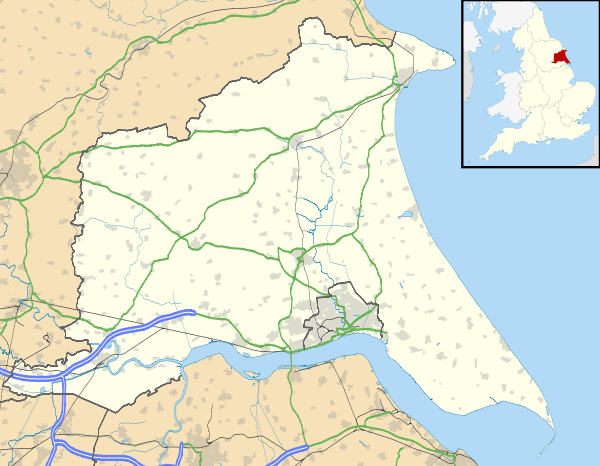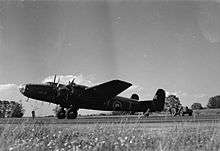RAF Pocklington
RAF Pocklington was an operational flying station of the Royal Air Force during the Second World War, forming part of Bomber Command, and operating primarily Wellington and Halifax bombers. The station, adjacent to the town of Pocklington at grid reference SE790485, opened in 1941, and was closed in 1946.[1] After a return to agricultural use, the station now forms an industrial estate and a restricted use airfield for a gliding club.
RAF Pocklington | |||||||||||||||
|---|---|---|---|---|---|---|---|---|---|---|---|---|---|---|---|
 View across the airfield (2006) | |||||||||||||||
| Summary | |||||||||||||||
| Airport type | Military | ||||||||||||||
| Operator | Royal Air Force | ||||||||||||||
| Location | Pocklington | ||||||||||||||
| Coordinates | 53°55′39″N 000°47′55″W | ||||||||||||||
| Map | |||||||||||||||
 RAF Pocklington Location in the East Riding of Yorkshire | |||||||||||||||
| Runways | |||||||||||||||
| |||||||||||||||
History
Work started on RAF Pocklington in August 1940, with the design for grass runways, along with hangars, technical buildings and administration blocks. This was changed during construction to include three concrete runways. Late into the building of the three runways, it was realised that the runway 3 (07-25 at 1,300 yards) posed a threat to the nearby village of Barmby Moor, and so was abandoned in favour of a fourth runway (13–31 at 1,600 yards).[2]
Three hangars were originally constructed, and these were supplemented by two additional hangars constructed on the other side of the main A1079 road.[2]
The station at RAF Elvington was originally built as a sub station of Pocklington, and along with RAF Melbourne became known as 42 base, within the 4 groups of Bomber Command.[3][4] Despite being the smaller station, RAF Elvington was operational long after the closure of Pocklington.[3]
Occupying squadrons
The first occupants of the site in 1941 were the Royal Canadian Air Force unit of 405 squadron, operating Wellington bombers for 84 raids in eleven months, during which 20 aircraft failed to return.[2]

In April 1942, the squadron changed to Halifax bombers, flying a further 20 raids before exchanging bases with the Royal Air Force 102 squadron from RAF Topcliffe, and were the last unit to occupy the station until its closure (although a personnel holding unit was briefly based at the base in 1946).[2]
The station transferred to Transport Command the day before the end of the war, operating B-24 Liberator aircraft before their transfer to RAF Bassingbourn.[2]
Subsequent use
Following the closure of the station, it was mostly returned to agricultural use, with the hangars used as grain stores,[2] but subsequently the technical area became an industrial estate, and a large number of buildings still stand.[5]
The original runways are still in use by the Wolds gliding club, who secured the lease to the airfield in 1971,[6] and purchased it outright from the land owner in 1983.[6] Former members of 102 squadron still hold reunion events at the gliding club.[7]
References
- "Pocklington". Control Towers. Retrieved 27 May 2009.
- "Bomber Command – Pocklington". Royal Air Force. Retrieved 27 May 2009.
- "RAF Elvington Airfield – A Brief History". Yorkshire Air Museum. Retrieved 27 May 2009.
- "102 (Ceylon) Squadron". Pocklington Town Council.
- "Pocklington". Airfields in Yorkshire.
- "History of the wolds gliding club". Wolds Gliding Club.
- "102 squadron hold their annual re-union at the Gliding Club". Pocklington Town Council.
| Wikimedia Commons has media related to RAF Pocklington. |
